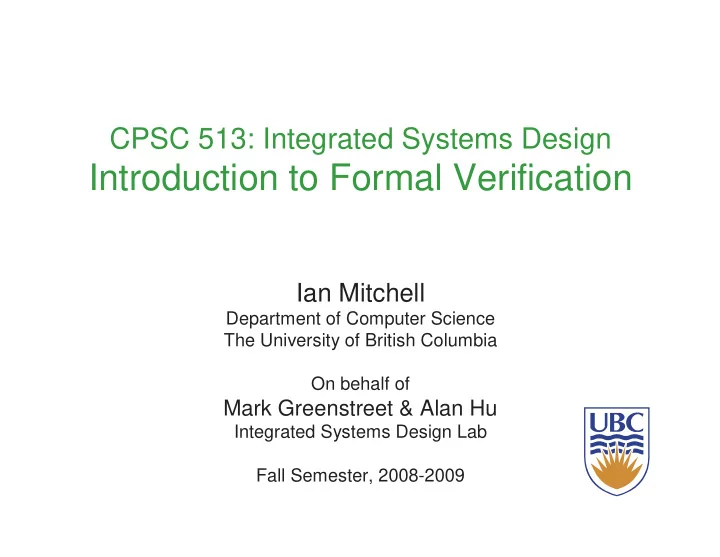

CPSC 513: Integrated Systems Design Introduction to Formal Verification Ian Mitchell Department of Computer Science The University of British Columbia On behalf of Mark Greenstreet & Alan Hu Integrated Systems Design Lab Fall Semester, 2008-2009
What is Verification? product creation (one engineer’s view) market research product sales & & funding engineering support verification design production testing & validation informal formal simulation model checking theorem proving equivalence Lyapunov emulation checking functions 9 Sept 08 Ian Mitchell (UBC Computer Science) 2
Why Use Formal Verification? • Preproduction verification & validation – Physical prototypes are too slow, costly, complex, and/or dangerous to use during iterative design – Much cheaper to discover bugs earlier in the design process • Simulation for early design work – User designed test cases can find most bugs – Random testing can uncover unexpected bugs – Comprehensive input and/or behavior coverage is often impossible • Verification for (some) late design work – Safety critical or high reliability applications must not fail – May be easier, cheaper and/or faster to apply formal methods than to design comprehensive tests 9 Sept 08 Ian Mitchell (UBC Computer Science) 3
Course Topics I • Introduction – Overview: why should you take this course? – Administrivia: how do you get a good grade (and hopefully learn something)? • Circuit equivalence, BDDs and SAT • Dynamic models and logics – Transition systems, finite state machines & automata – Well-posed models, Markovian assumption, nondeterminism – Temporal logics: CTL – Safety, liveness & fairness • Model checking – Explicit state – Symbolic • Software verification 9 Sept 08 Ian Mitchell (UBC Computer Science) 4
Course Topics II • Fixpoint methods – Concurrent models: synchronous & asynchronous – Weakest precondition – Invariants & progress functions – Synchronized Transitions • Timed automata – Finite state bisimulation • Hybrid systems – Differential equations for continuous systems – Well-posed hybrid models – Lyapunov functions – Reachability • Models of computation – Soundness, completeness and complexity – Moving between MoCs 9 Sept 08 Ian Mitchell (UBC Computer Science) 5
Administrivia • http://www.cs.ubc.ca/~mitchell/Class/CS513.2008W1 • Prerequisites: – Graduate standing (CS, math, engineering) – Backgrounds vary, so will try to keep course self-contained – Be comfortable with logic and proof • Grades – 3 – 5 homework assignments and/or leading class discussions – Course project (proposal, oral presentation, written report) • Collaboration – Work together on the problem, but write your own solutions – Cite your sources • References – No required text – No course notes – Many research papers 9 Sept 08 Ian Mitchell (UBC Computer Science) 6
Conceptual Framework • Models – How do we describe the behavior of the system? – Circuits, finite state machines, programs, differential equations, … • Goals – What verification or validation task would we like to accomplish? – Equivalence, safety, liveness, fairness, refinement, … • Techniques – What mathematical framework allows us to formally state the problem and determine a solution? – Canonical forms, reachable sets, restricted design languages, Lyapunov functions, fixpoint iteration, … • Tools – How do we implement the operations of our technique? – Binary decision diagrams, Hamilton-Jacobi PDEs, compilers, … • Case studies – Real problems validated or verified 9 Sept 08 Ian Mitchell (UBC Computer Science) 7
Recommend
More recommend